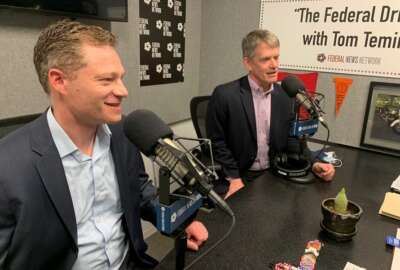
Federal procurement fraud occurs more often than you might think
The FBI has opened more than two dozen grand jury investigations this year alone related to federal contracting fraud.
Best listening experience is on Chrome, Firefox or Safari. Subscribe to Federal Drive’s daily audio interviews on Apple Podcasts or PodcastOne.
One might be surprised to learn the FBI has opened more than two dozen grand jury investigations this year alone related to federal contracting fraud. Its Procurement Collusion Strike Force is using some up to date techniques like data mining for contractors – honest ones, that is – it all means the need for strong compliance programs. For more, Federal Drive with Tom Temin spoke to Jon Jacobs and Alex Canizares, partner and senior counsel, respectively, from the law firm Perkins Coie.
Interview transcript:
Tom Temin: And let’s begin at the beginning here, and tell me a little bit about this phenomenon of contracting fraud. Is this mostly something that happens with collusion among contractors? Or is it something that happens between the government and contractors as a rule?
Jon Jacobs: Yeah, the kind of fraud we’re talking about here, Tom, is contractor-to-contractor collusion. So what the Strike Force is focusing on is bid rigging, price fixing or market allocation among contractors who are bidding for federal contracts. They will get together beforehand, and they will decide who is going to win a particular bid, the one who’s going to submit a higher or complimentary bid will know what the prearranged winner is going to bid. And so it’s all set up so competition is eliminated. The agency, the federal government is not involved. So this is very different than say kickbacks to federal contractors in order to steer contracts a certain way.
Tom Temin: Sure. And then I guess, for the contractors involved, the ones who agree to “lose” then get some sort of consideration, I guess, for the winners in general?
Jon Jacobs: They do. These bid-rigging conspiracies are often set up so that if Alex and I are the two natural bidders for a contract, we’ll get together and I’ll say, Alex, let me have this one, please bid above this certain price, and the next one’s yours.
Tom Temin: And I guess the question is, how often does this happen? I mean, there’s a couple of dozen out of what 15- 20,000 contracting actions a year and 2,000 of them roughly are protested. I mean, this is a big business. So I guess I’m asking in general, is the system in the United States corruption-free with exceptions? Or is it – tend to be maybe the noncorrupt ones are the exceptions?
Alex Canizares: According to the FBI, which issued a report in [May] of this year, this is a significant issue. They cite a study that says that about 20% of procurement is tainted by some sort of bid rigging. And whether or not that study is true, if you think about $500 billion-plus of federal procurement activity every year, this is something that is going to have a significant impact. And this Procurement Collusion Strike Force recognizes that, kind of renews the focus that the law enforcement community has.
Tom Temin: By the way, your number’s a little out of date – during the pandemic, it was more like $639 billion. So there’s a lot of room for collusion I guess, drug companies and mask companies or whatever. And is it generally more on to the extent we know, on the DoD side or the civilian side?
Alex Canizares: Well, it’s really everything. I mean, I think the areas of focus for this particular Interagency Task Force include Defense. There was just another indictment announced last week in the Defense context, but also health care. And you mentioned the pandemic, and I think the significant increase in federal spending and response to the pandemic heightens the concern. And it’s not specific to COVID but if you think about infrastructure, that’s another area I think we’ll see renewed focus on, especially with talks underway about increased spending on transportation and infrastructure. But really, it’s not agency-specific, it’s not just DoD. These are many, many law enforcement agencies, and inspectors general and different agencies that are now on heightened alert for this issue.
Tom Temin: And, Jon, you did have experience in the Justice Department earlier in your career. Is there any clue that a contracting officer can discern that might tip him or her off that something’s un-kosher going on here?
Jon Jacobs: Yes. And actually, the Antitrust Division as a part of this new initiative has published the so-called red flags of collusion on their website. And the red flags are designed for contracting officers to know what to look for. It’s not completely comprehensive, but some of the examples are, are there a small number of bidders for this particular kind of contract? Because obviously, it’s easier to collude if you don’t have a large number. Are there similar-looking bid proposals? Is there similar handwriting, similar typographical errors? Does it look like the different bids were prepared by the same person because believe it or not, sometimes these conspirators aren’t careful enough. And it’s very suspicious when you lay them all out in the table. And then take a look at the patterns not only the prices, but the patterns of winning. As I said before, the way these bid rigging conspiracies usually work is, if Alex and I are supposedly competing, we’re rotating. And so if it looks like Alex is winning about 50%, I’m winning about 50% – that’s a red flag.
Tom Temin: Sounds like high school construction contract. We’re speaking with Jon Jacobs and Alex Canizares. They are partner and senior counsel at the law firm Perkins Coie. And tell us more about the FBI task force. It’s an interagency affair. Who’s involved and maybe a little bit about the data mining and data experts they’ve gotten on board?
Alex Canizares: Well, it’s not just the FBI, it’s actually led by the Antitrust Division within the Department of Justice. FBI is a principal law enforcement agency that’s involved. But you’ve actually got a total of 29 either U.S. attorney’s offices or agencies, and that includes the inspectors general who already have their own oversight function looking for this sort of conduct. I do want to mention one aspect of the red flags, which is important here, too, which is contracting officers that conduct competitive procurements are already required by statute and regulation to be on the lookout for this sort of antitrust activity. And so when they are reviewing contract proposals in a procurement, they’re already supposed to notify the Department of Justice for this sort of thing. What this particular task force does, is really two things. One is bring new cases. And the other part is really bring about more awareness, educate people, and train people, and they’ve done a significant amount of training in that regard.
Tom Temin: Alright, so let’s get to some of the advice your law firm has put forth for contractors that don’t want to be seen as doing this. And also, I guess there’s the situation where it could occur because of some employees, but you can protect the corporation, even if those people get punished and go to jail somehow. So what should contractors do to stay out of this?
Jon Jacobs: Yeah, the very first thing I would advise is to update your compliance program. That is particularly important for avoiding any kind of antitrust offense and particularly recently, given some DOJ guidance, and there’s at least a couple of reasons for this. I mentioned the so-called leniency program and then Alex, maybe you can describe the recent availability of deferred prosecution agreements that are available to those with otherwise effective compliance programs. So the Antitrust Division has a leniency program. And what that is, is if you are the very first individual or company to notify the Antitrust Division of a conspiracy that it has not heard about before, you get complete immunity. You will not be charged, you won’t be fined, your executives won’t go to jail. Remember, the antitrust laws do involve jail terms, potentially, for executives that participate in this activity. Now, you’re still going to have to cooperate and that can be quite an effort. You’re going to have to hire a lawyer, unfortunately, you’re going to have to proffer your facts of your internal investigation, you’re going to have to produce documents and make your executives available for an interview with the criminal prosecutors. But it’s also available only for the first to contact the DOJ. There is a race for leniency. So it’s important if you see something right away, say something.
Tom Temin: Is there, by the way, any qui tam possibility for someone that might be lower down in the company that blows the whistle on this?
Jon Jacobs: There absolutely is and some of my criminal cases started with a qui tam complaint.
Tom Temin: Got it, okay and what else?
Alex Canizares: Well, one of the things that contractors can really do to kind of mitigate the risk of this sort of enforcement activity is to, as Jon says, build a robust compliance program, have those internal controls in place, but also be specifically aware of the risks that the DOJ is looking at. These same red flags of collusion are things that companies within their own company can sensitize their employees to. That’s the procurement folks, that’s the people who are doing the business development and that sort of thing. And it also means having a very specific reporting mechanism. So if people see something, they can bring it to the attention of the appropriate person. The False Claims Act, in terms of qui tam is another aspect of this. It’s not particularly within the purview of this program. But it’s certainly reasonable to expect that if people are identifying potential fraudulent activity that could result in a False Claims Act matter.
Tom Temin: Alright, and a couple of lightning round questions here at the end, does this tend to be as far as you can tell more in the services or in the products acquisition area?
Alex Canizares: I would say it’s not limited to either one. I think that the areas that we’re looking at now, in terms of recent announcements, we had one very recently in the infrastructure sector that was more service oriented. But really, I think there’s likely to be cases on both sides of that fence.
Tom Temin: And the second question is, more and more contracting dollars are going through government wide acquisition contracts as GWACs as task orders, as opposed to full an open. And so is it more an occurrence in full and open competition, or do you find it in the GWAC task orders also?
Alex Canizares: It’s an interesting question. I don’t think it’s off the table in terms of a GWAC context. I mean, as you say, there are situations and it’s not limited to the GWACs but where sole source contracting is perfectly permissible. The concern in this particular area is where competition is required. And I think that’s where companies, particularly if they’re engaged in teaming arrangements, need to be very sensitized to what the risks are.
Tom Temin: Alex Canizares is senior counsel at the law firm Perkins Coie, thanks so much.
Alex Canizares: Thank you.
Tom Temin: And Jon Jacobs is a partner there. Thank you very much.
Jon Jacobs: Thank you, Tom.
Copyright © 2025 Federal News Network. All rights reserved. This website is not intended for users located within the European Economic Area.
Tom Temin is host of the Federal Drive and has been providing insight on federal technology and management issues for more than 30 years.
Follow @tteminWFED




